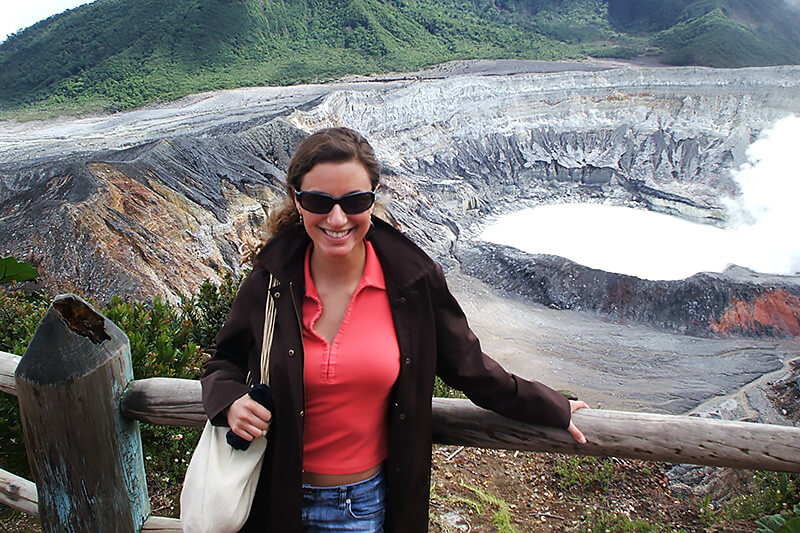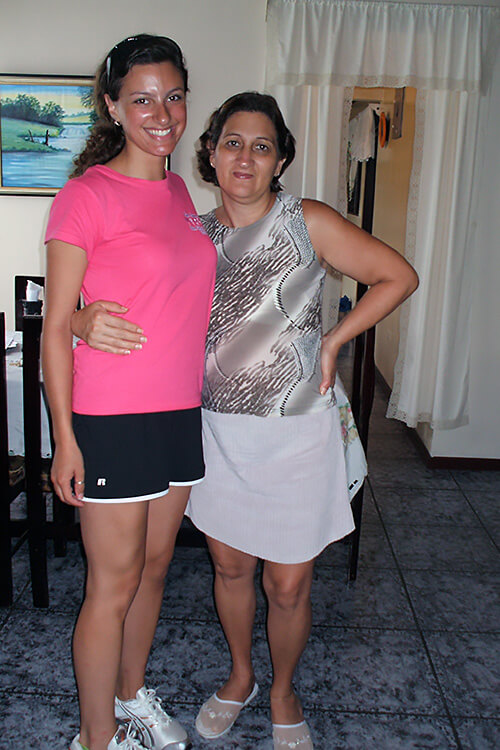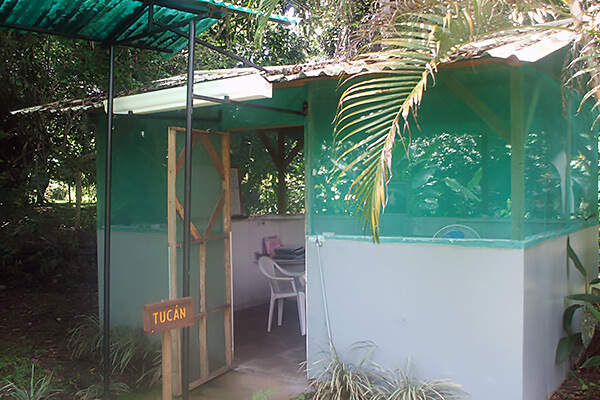Learning Medical Spanish in Costa Rica
Living and Immersing in Pura Vida as a Student
Article and Photos by Regina Toto

|
|
Regina was at the Volcan Poas outside of San Jose during orientation.
|
Finding a Language Program in Costa Rica
After learning about the importance of cultural sensitivity in my Sociology of Medicine course, I decided that to relate to my patients fully, I would need to speak in a language they could understand. I took four years of Spanish in high school but did not choose to continue the language in college; therefore, a course in medical Spanish naturally seemed the best way to refresh my conversational skills while developing my ability to translate medical terminology. Armed with a strong sense of purpose and a $3,000 scholarship grant for an academic pursuit, I set to find the ideal medical Spanish program for my needs and goals. I punched various combinations of search terms into Google, clicking on any remotely interesting result. I quickly realized that the Internet is a vast repository of study abroad resources just waiting to be tapped. One particular program that stood out to me was the Adventure Education Center’s Deluxe Medical Spanish program in Costa Rica. The Center’s offerings of small classes, program excursions, and a host family stay were a combination I could not resist.
Before committing to the AEC Medical Spanish program, I needed to do more homework. First, I emailed the program director asking for the contact information of previous participants. This proved a critical step in deciding whether to commit and choosing which of the three Costa Rican locations I would study. After numerous positive testimonials arrived in my inbox, I was confident that an AEC program would be worth the trip. Next, I had to ensure that medical Spanish classes would not interfere with the summer internship I had already accepted at home. Thankfully, AEC allows its students to stay for as many (or as few) weeks as they would like; I successfully booked a 3-day orientation followed by two weeks of classes, which allowed me to return to the U.S. in time for my internship. Finally, to justify my receipt of the $3,000 grant, I needed to assemble a budget including all my expenses for the trip. Through AEC’s program director, I learned the costs of a typical Costa Rican lunch, my bus fares to and from the program site, and a zip-lining excursion — among many other things. The research paid off when I received the grant and purchased my plane tickets to San Jose.
Preparing for Costa Rica
After purchasing my tickets, the first thing I did to prepare for my trip was to investigate which (if any) vaccines I should receive before entering Costa Rica. It is vital to take care of vaccinations as soon as possible once your travel arrangements are made. Certain vaccines are only effective if received a certain period before arrival. I explored the CDC’s Traveler’s Health page on Costa Rica. I went to my school health center to receive vaccines for hepatitis A and typhoid.
After purchasing my tickets, the first thing I did to prepare for my trip was to investigate which (if any) vaccines I should receive before entering Costa Rica. It is vital to take care of vaccinations as soon as possible once your travel arrangements are made. Certain vaccines are only effective if received a certain period before arrival. I explored the CDC’s Traveler’s Health website. I went to my school health center to receive vaccines for hepatitis A and typhoid.
Besides taking these health precautions, I was also prepared to encounter Costa Rican culture and be immersed in Spanish. First, I wanted to bring a gift to my host family to thank them for housing me. I had yet to learn what would be appropriate. So, I asked the AEC program director, who advised me to bring something unique to my hometown. This was great advice; my family devoured the packaged foods I brought. In addition to preparing to meet my host family, I needed to refresh my Spanish-speaking skills. I had not taken Spanish classes in almost three years, so naturally, I felt unprepared and nervous. I reviewed my notebooks from high school, watched some Telemundo here and there, and wrote a bunch of letters to a friend in Spain (in Spanish) to re-orient my brain to think in the language. Whether or not these preparations actually enhanced my speaking ability in Costa Rica, they definitely relaxed me. They eased my transition into a Spanish-speaking environment.
Handling the Transition
It is indispensable to force yourself to speak in Spanish as much as possible while also remaining patient and maintaining a positive attitude to cope with culture shock and eventually overcome the language barrier in Costa Rica. Never having spent more than a few days in a Spanish-speaking country, I underestimated how alienated and discouraged I would feel when everyone spoke a different language. When I first arrived for orientation in San Jose, I was too nervous to say anything more than “gracias” and “por favor” in Spanish; instead, I slipped into English with the program staff and looked forward to the arrival of more American students. A few days later, I boarded a bus to the small town of Turrialba, where my host family would pick me up. I felt so nervous that I almost got physically sick on the bus ride — I dreaded stepping off the bus and speaking Spanish to communicate.
Surprisingly, once I was forced to listen and speak Spanish, I became increasingly comfortable and improved my fluency. I learned to listen carefully as my family members spoke and to answer them as slowly as I needed to without feeling stupid or embarrassed. The more I relaxed, the more accessible communication became. In situations when I did not know the proper Spanish equivalent of a word I wanted to say or when my host dad spoke a little too quickly for me to understand, I learned the value of asking questions: Perdon? (Pardon me?) Lo puede repitir, por favor? (Can you repeat that, please?) Que significa? (What is the meaning?). Additionally, I relied on gestures to supplement words; body language — nearly universal across cultures — proved very useful in communication with los ticos. I chose to live in Turrialba over the other two locations offered to us because former students told me that virtually everyone spoke Spanish. I also hoped to gain speaking practice through living with a host family. In retrospect, I realize that while these two choices made my first few days in Costa Rica a little more complicated, they really helped maximize the improvement of my language skills over an incredibly short period.

|
|
Regina with her host mother, Yenory.
|
When you become comfortable speaking the language and are motivated to go out and explore town, you must remember to exercise caution. I first studied abroad in Bath, England, where safety was less of a concern than in Costa Rica. Although my teachers and host family reassured me that the Turrialba streets were safe to walk, I ensured that I always looked alert. The Costa Rican people, known as ticos, are amiable and always willing to talk. Costa Rican men — and Latin American men in general — tend to freely voice their opinions about pretty girls on the street. A few times, a group of guys approached my classmates and me as we walked into the center of town, yelling things like guapas and various other expressions that I am glad I could not understand.
On the one hand, it was flattering, but on the other hand, I realized that we stuck out like sore thumbs and the guys probably recognized us as tourists. Thankfully, I never carried more money on my person than I would need that day; additionally, I kept my passport, plane tickets, and debit card locked in a drawer at my host family’s house. When I did need to carry my passport, such as the day I went to the bank to pay my exit taxes, I brought it in a pouch that rested underneath my shirt. When exploring, I recommend going with friends, making a point to be aware of your surroundings, carrying as few valuable items as possible, and storing paper copies and electronic backups of your documents on a secure Cloud system for easier retrieval and peace of mind.
Cultural Immersion in Costa Rica

|
|
Experience one of the AEC Turrialba outdoor classrooms in Costa Rica.
|
The AEC Medical Spanish program facilitates cultural immersion by incorporating interaction with the locals and engagement with current Costa Rican issues into the curriculum. Each weekday began with four hours of personalized, one-on-one Spanish conversation and language instruction. During this time, my professor would inform me about one particular aspect of Costa Rican society and ask me to respond, giving my opinion and comparing and contrasting similar situations in the United States. For example, we spent one class discussing the changing role of women in Costa Rican culture. Whereas women typically maintain the household and raise children while the men go out to work, increasing numbers of ticas seek college educations and professional positions.
During the second week of classes, my professor tailored virtually every lesson to my interests while challenging me to get closer and closer to fluency. After discovering that I played the clarinet, she took me to town to meet her father, the director of Turrialba’s community orchestra. I interviewed him about participation in the group and the financial challenges of providing instruments and funding concerts. Although I struggled with some musical vocabulary, I ultimately really enjoyed the experience of asking questions and responding to a native speaker. The unique integration of language practice and cultural encounters — a hallmark of the AEC academic experience — allowed me to learn quickly.
The combination of immersion and language learning was also vital in achieving my goal of learning medical Spanish. Three afternoons per week, I took a 2-hour medical Spanish class taught by a physician (who spoke almost no English) and participated in different medically related activities. We took one particularly memorable trip to an orphanage outside Turrialba to interview the staff about the children’s medical histories and conditions. Many children end up in Costa Rica’s orphanages not because their parents have died but because they have debilitating medical conditions that require expensive, round-the-clock care. Fortunately, other families (some Costa Rican, but primarily European) with the time and means to care for such children often adopt them. Normally, I would have expected that the children of teenage mothers would primarily comprise the populations of Costa Rican orphanages. Adolescent pregnancy is relatively common in Costa Rica, in large part due to the Catholic Church’s influence on the government and their recommendation that sex education begin no earlier than age 16. Abortions are highly uncommon in Costa Rica, but usually, babies born to teenaged mothers are cared for by the young woman’s family rather than placed in orphanages. In all aspects of Costa Rican life, family ties are of paramount importance and strength.
When not busy taking classes, I seized the opportunity to participate in recreational activities offered through AEC. The program fee includes one cooking and one dance class per week, which proved enjoyable and yet another way to learn about Costa Rican culture. Two trips to tourist attractions were included: one to Guayabo, a pre-Columbian archaeological site, and one to a Serpentarium filled with virtually every species of Costa Rican snake. AEC is involved in a partnership with Explornatura. This company runs various adventure trips in the lush Costa Rican wilderness: river rafting, canyoning, zip-lining, and horseback riding are just a sampling of the options. Participating in these afternoon excursions was a great way to leave the books for a while and see the gorgeous landscapes for which Costa Rica is so famous.
Pura Vida
Devoting two and a half weeks to studying Spanish and medical Spanish taught me much more than language vocabulary. I learned the importance of leaving my comfort zone and confronting fears rather than avoiding them. Speaking Spanish whenever possible, while challenging, allowed me to develop a close relationship with my host family while achieving maximum improvement in my conversation skills. Additionally, thanks to AEC and my determination, I gained a sense of Costa Rican culture never imagined. The combination of academic program, experiential learning, and community integration can only be described as pura vida, literally translated as “pure life,” or the Costa Rican equivalent of saying, “this is living.”
Lessons Learned in Costa Rica
-
To gain inspiration through classes. I first became interested in medical Spanish through a Sociology of Medicine course. My final paper dealt with cultural sensitivity in medical practice; overcoming language barriers is a large part of bridging the cultural gap between doctor and patient. My desire to become a more culturally sensitive doctor led me to medical Spanish and eventually to AEC.
-
I listened to previous participants. Talking to previous participants helped me decide whether or not to join AEC and, beyond that, which of the three locations to choose.
-
Confronting my fears head-on, rather than avoiding them, was a transformative experience. Initially, relying on gestures and English seemed like a safe option. Regardless, it did little to alleviate my fear of speaking Spanish. Only when I challenged myself to speak the language did I truly improve and feel more at ease.
-
Living with a host family completely changed my perspective, giving me a unique opportunity to eat, speak, and live like a local, significantly enriching my understanding of Costa Rican culture.
-
To make study abroad work for me. Since I had already secured a summer internship back home in Philadelphia, I only had a few weeks to travel. Nevertheless, I had an intense, enriching experience by maximizing time spent speaking Spanish, participating in one-on-one Spanish classes, and taking excursion opportunities.
For More Info
See Articles and Resources on Costa Rica for more.
Adventure Education Center’s Medical Spanish Program
CDC’s Traveler’s Health page on Costa Rica
|
Regina Toto grew up in Drexel Hill, Pennsylvania, and enjoys reading and traveling in her free time. She is a senior at Franklin & Marshall College in Lancaster, PA. Regina graduated in 2009 with a degree in English Literature and a minor in Medicine in Society. She then started her studies at the George Washington University School of Medicine in the fall, which she completed in 2013 before starting her career as a Physician in Pediatrics.
|
